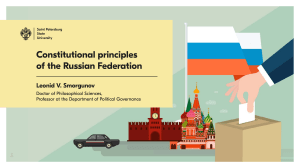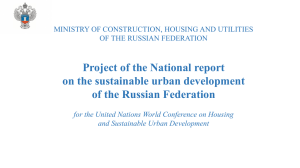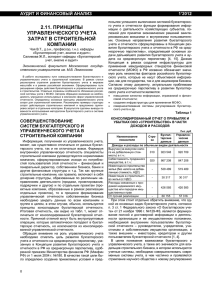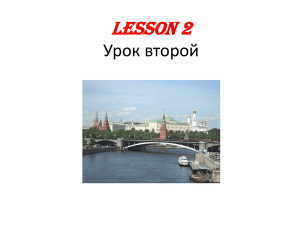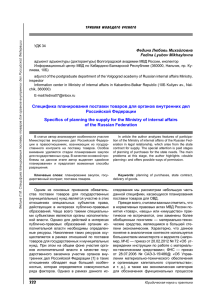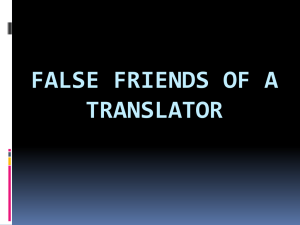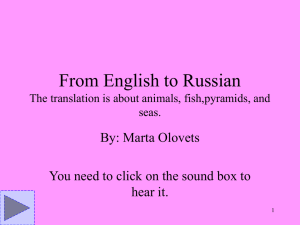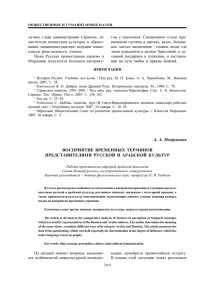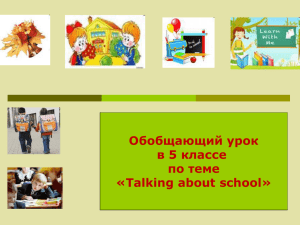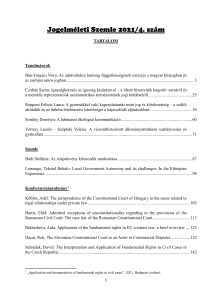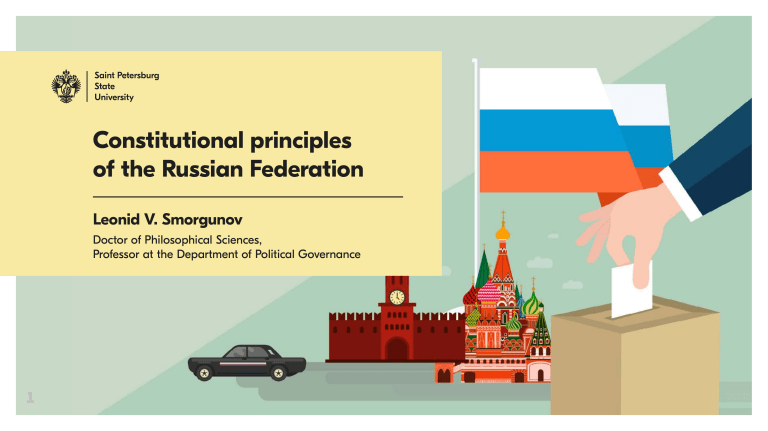
Constitutional principles of the Russian Federation Leonid V. Smorgunov Doctor of Philosophical Sciences, Professor at the Department of Political Governance 1 Topic 1: Constitutional principles of the Russian Federation The aim of this topic is to give you the general information on the Constitution of the Russian Federation, its foundations and problems of realization. 3 General data on Russia 4 Year Category Data 2017 Population 146,8 mln 2017 Territory 17 mln km² 2010 Ethnic groups 200 2015 Religion 70% Orthodox; 5% Muslim 2017 Urban population 74% 2016 GDP per capita $ 26,5 thousand 2012 Gini coefficient 0,42 The real war for power in October 1993 between the President of Russia Boris Yeltsin and the Supreme Soviet. Two different principles of power: a separation of power against a sovereignty of the Supreme Soviet. rbcdaily.ru 5 Article 1 The Russian Federation – Russia is a democratic federal law-bound State with a republican form of government. The names "Russian Federation" and "Russia" shall be equal. 6 The Fundamentals of the Constitutional System • Democracy. 7 The Fundamentals of the Constitutional System • Democracy. • Sovereignty. 8 The Fundamentals of the Constitutional System • Democracy. • Sovereignty. • Separation of powers. 9 The Fundamentals of the Constitutional System • Democracy. • Sovereignty. • Separation of powers. • Constitutional review. 10 The Fundamentals of the Constitutional System • Democracy. • Sovereignty. • Separation of powers. • Constitutional review. • Priority of human rights and freedoms. 11 The Fundamentals of the Constitutional System • Democracy. • Sovereignty. • Separation of powers. • Constitutional review. • Priority of human rights and freedoms. 12 • Rule of law. The Fundamentals of the Constitutional System • Democracy. • Rule of law. • Sovereignty. • Republicanism. • Separation of powers. • Constitutional review. • Priority of human rights and freedoms. 13 The Fundamentals of the Constitutional System • Democracy. • Rule of law. • Sovereignty. • Republicanism. • Separation of powers. • Federalism. • Constitutional review. • Priority of human rights and freedoms. 14 The Fundamentals of the Constitutional System • Democracy. • Rule of law. • Sovereignty. • Republicanism. • Separation of powers. • Federalism. • Constitutional review. • Local self-government. • Priority of human rights and freedoms. 15 The Fundamentals of the Constitutional System 16 • Democracy. • Rule of law. • Sovereignty. • Republicanism. • Separation of powers. • Federalism. • Constitutional review. • Local self-government. • Priority of human rights and freedoms. • Separation of religion from the state. The Russian state symbols 17 References 1. Rbcdaily.ru 2. http://www.kaluga-poisk.ru/novosti-kaluga/zakon/-v-kaluzhskih-shkolahhotyat-otvesti-vremya-na-obyazatelnoe-ispolnenie-gimna-rf 18 Russian Political System and Regime Part I Aleksandr S. Sherstobitov Candidate of Political Sciences, Assistant Professor at the Department of Political Governance 19 Key questions • The relation between institutional design and political regime? • Approaches to understand the political regimes in contemporary world? • The key factors of the evolution of Russian political system and regime? • The contemporary political regime in Russia. 21 Political institutions and regime Political institutions are organizations and recognized rules and principles that provide a framework for creation, enforcement, and application of laws, and determine [governmental] public policy. Political regime in a broad context is the way how political institutions work. 22 Types of Political regimes • Democratic regimes. • Hybrid regimes (anocracies?): –– Oligarchic democracy; –– Controlled democracy; –– Electoral democracy. • Non-democratic regimes. 23 Regimes in the world Democracy index map of 2016. Source: The Economist Intelligence Unit. 24 Regimes in the world Polity IV data series report (2013). Source: The Polity IV Project. 25 Institutionalization of Russian political system since 1993 • Constitutional process. • Implementation of democratic institutions: Constitution, legislature, government, judicial branch of power, separation of powers, elections, etc. • Development of new mechanisms of political governance. • Establishment of party system. • Development of institutions of civil society. • Institutionalization of interest groups. 26 Russian Political system at the Federal level Legislative Branch of Power • Federal Assembly of the Russian Federation: –– Council of Federation: 2 deputies from each unit of federation; –– State Duma: 450 deputies elected according to mixed electoral system. 27 Russian Political system at the Federal level Executive Branch of Power • Chair of Government (Prime-Minister). • Government of the Russian Federation: –– Ministries of the RF; –– Federal Services; –– Federal Agencies. 28 Russian Political system at the Federal level Judicial Branch of Power • Constitutional Court. • Supreme Court: –– Judicial Colleges. 29 Russian Political system at the Federal level Judicial Branch of Power • Constitutional Court. • Supreme Court: –– Judicial Colleges. Where is the president? 30 References 1. Democracy index map of 2016.The Economist Intelligence Unit. Available at: http://www.eiu.com/topic/democracy-index 2. Polity IV data series report (2013) The Polity IV Project. Available at: http://www.systemicpeace.org/polity/polity4.htm 31 Russian Political System and Regime Part II Aleksandr S. Sherstobitov Candidate of Political Sciences, Assistant Professor at the Department of Political Governance 32 The President of the Russian Federation • Guarantor of the Constitution. • Issues decrees. • Nominates Judges of the Constitutional Court and Supreme Court. • Nominates Chairs of Government and Central Bank. • Chief Commander. • Determines objectives in domestic policy. • Represents RF in international relations. 34 Super-Presidential Power: legislative process • President has the right of legislative initiative. 35 Super-Presidential Power: legislative process • President has the right of legislative initiative. • President has the veto right. 36 Super-Presidential Power: legislative process • President has the right of legislative initiative. • President has the veto right. • President can issue decrees that are obligatory for the Government. 37 Super-Presidential Power: legislative process • President has the right of legislative initiative. • President has the veto right. • President can issue decrees that are obligatory for the Government. • The decrees are not the laws but their function as next to laws normative acts. 38 Super-Presidential Power: legislative process • President has the right of legislative initiative. • President has the veto right. • President can issue decrees that are obligatory for the Government. • The decrees are not the laws but their function as next to laws normative acts. • In case governmental normative acts are in contradiction with the Constitution, federal laws or the decrees of the president he has the right to revoke these acts. 39 Super-Presidential Power: legislative process • President has the right of legislative initiative. • President has the veto right. • President can issue decrees that are obligatory for the Government. • The decrees are not the laws but their function as next to laws normative acts. • In case governmental normative acts are in contradiction with the Constitution, federal laws or the decrees of the president he has the right to revoke these acts. • President has the right to dissolve State Duma in case it disapproves President’s nominee for the position of Chair of Government three times in a row. 40 Super-Presidential Power: executive process • President: –– Ministry of Defense; –– Ministry of International Relations; –– Ministry of Interior (Police); –– Ministry of Emergency Situations; –– Federal Security Service; –– Intelligence Service; –– National Guard Service. 41 • Chair of Government: –– Economic bloc (finances, economic development, transport, telecommunications, etc.); –– Social bloc (science and education, health care, etc.). Key question at this point • There were three different Presidents in Russian Federation. The first experience of super-presidency can be found during Yeltsin's presidency in 1996–1999. However, just Vladimir Putin is considered to be the one who obtained super-presidential power. • Even though Dmitry Medvedev’s term was between Putin’s terms, he was not the Super-President. Why? 42 The “Vertical of Power” • “Party of Power” that got majority in State Duma: –– “Yedinstvo” + “Fartherland – All Russia” = United Russia; –– Withdrawal of oligarchs from political decision-making; –– Federal districts, control of Governors’ elections and nominations; –– Consolidation of elites; –– Policy of stabilization (economic growth and redistribution of rent); –– Reprivatization of the key industrial assets. 43 Approaches to describe contemporary political regime in Russia • Controlled democracy. • Electoral authoritarianism. • Soft authoritarian governance. 44 Russian Federalism: Economy, Politics, Culture Kirill A. Neverov Candidate of Political Sciences, Assistant Professor at the Department of Political Governance 45 Subjects of the Russian Federation 47 Federal Districts of the Russian Federation 48 Political Culture in Russia: Traditions and Forms Anna V. Volkova Doctor of Political Science, Associate Professor at the Department of Political Governance 49 Kremlin-oriented Political Culture The Kremlin of Nizhny Novgorod Built in the years 1500–1511 51 Kremlin-oriented Political Culture The Kremlin in Moscow Built in the years 1482–1495 52 Autocracy in proverbs • Even the worst Tsar is better than “Semiboyarshina” (seven boyars). • The world doesn’t live without God, the Land is not ruled without Tsar. • Russia without Tsar is like a widow and the nation without Tsar is like an orphan. • Tsar is good, boyars are bad. 53 Attitude to laws in proverbs • The law is a pole (beam, shaft), you can turn it as you want. • The law is like a drawbar of a cart, it points wherever you turn it to. • The court is straight, but the judge is crooked. • Do not be afraid of a law – be afraid of a judge. • New lords, new laws. • If the pocket is empty, the judge is deaf. 54 Riots and Protest Tradition “Salt riot” was a reaction to Russia's tax reform in 1648. It was the biggest city riot in Moscow in XVII century. “Salt riot” Artist: Lissner, E., 1938 55 Riots and Protest Tradition “Copper riot” was a reaction to the financial crisis in 1662 and the financial and taxis reforms: silver coins were replaced by copper coins. “Insurrection In Kolomenskoye” (“Copper riot”) Artist: Lissner, E., 1938 56 Riots and Protest Tradition In the picture all stages of the riot are shown. The Kremlin is in the centre. The Tsar is a key figure. “Copper riot” Artist: Butorin, D. N. Palekh, 1935 57 Riots and Protest Tradition “Strelets” (shooter) is a solder of the elite (tsars’) troop or guardsmen. These troops were powerful in Moscow State in XVI–XVII centuries. There were two “Streletskiy riots” (1682 and 1698) in Moscow. In 1698 it was organized against Peter I and was cruelly suppressed by him. “The morning of the Streltsy execution” Artist: Surikov, V. I., 1881 58 Riots and Protest Tradition Being a Holy fool was a form of socio-political protest in XVI–XVII centuries. “Boyarynya Morozova” Holy fool (the fragment) Artist: Surikov, V. I., 1887 59 Political humor as an important part of civilian protest Maslenitsa fest. The buffoons (skomorokhi) are singing “chastushki” (sung couplets). Buffoons (Skomorokhi) – Russian medieval actors. 60 Political humor as an important part of civilian protest Russian buffoons often criticized the Tsar, priests and boyars. “Puppeteers” Artist: Hodov, V. M. Palekh, 1980 61 Political humor in contemporary Russia “Kukly” (“Dolls”) was a very popular satirical program on the television channel “NTV” in 1994–2002. Dolls “Putin”, “Yeltsin” and “Gorbachev” 62 Russian political humor in Facebook “Usy Peskova” (Peskovs’ Mustache) and Politicana.ru D. Pescov is a press secretary of President. 63 Political humor as an important part of civilian protest in contemporary Russia The journalist interviews a demonstrator with toy ducks. They remind about the film dedicated to fancy residences of the Prime minister with a special house for his ducks. The forbidden political meeting against corruption Moscow, March 26, 2017 64 Russian democratic traditions Veche was a public council in Russian cities in the XV century. “Veche” Artist: Hodov, V. M. Palekh, 1984 65 Russian democratic traditions “Zemskiy Sobor” (The Assembly of the Land) was convened by the Tsar for discussing some political and economical issues. The Assemblies included the representatives of the main social groups (except peasants) and met in Moscow in XVI–XVII centuries. “Zemskiy Sobor” Artist: Ivanov, S. V. 1908 66 Russian political culture December 24, 2011, Moscow. The biggest protest in Russia in the last 20 years. More then 100 000 participants on Sakharov Avenue protested against the results of the parliament election. 67 Development of political culture in contemporary Russia • Traditions. • Contemporary political practice reflected in formal and informal institutions. • Foreign experience and impact of democratization. 68 References 1. 2. 3. 4. 5. 6. 7. 8. 9. 10. 11. 12. 13. 14. 15. 16. 69 Kremlin, Nizhny Novgorod https://www.shutterstock.com/ru/image-photo/nizhny-novgorod-kremlin-city-buildings-sunset-555898906 Kremlin, Red Square, Moscow https://www.shutterstock.com/ru/image-photo/kremlin-fortress-center-moscow-main-sociopolitical-594311048 E. Lissner, “Salt riot” , 1938 http://all-russia-history.ru/salt-riot-foto-1 E. Lissner, “Insurrection In Kolomenskoye” (“Copper riot”), 1938 http://all-russia-history.ru/copper-riot-foto-1 Butorin D.N., “Copper riot”, Palekh, 1935 https://www.shutterstock.com/ru/image-photo/ussr-circa-1976-postcard-printed-shows-94888642 Surikov V.I., The morning of the Streltsy execution, 1881 http://extremethings.net/image/nH Surikov V.I., “Boyarynya Morozova”, 1887http://www.russianartgallery.org/famous/surikov_morozova.htm Maslenitsa fest. The buffoons https://www.shutterstock.com/ru/image-photo/orel-russia-february-26-2017-maslenitsa-589107440 Hodov V.M., “Puppeteers”, Palekh, 1980 http://theatre-artefact.spb.ru/wp-content/uploads/2011/09/%D0%92% D0%B0%D0%BB%D0%B5%D0%BD%D1%82%D0%B8%D0%BD-%D0%A5%D0%BE%D0%B4%D0%BE%D0%B2-%D0 %9A%D1%83%D0%BA%D0%BE%D0%BB%D1%8C%D0%BD%D0%B8%D0%BA%D0%B8-1980.jpg Dolls “Putin”, “Yeltsin” and “Gorbachev.” “Kukly” (“Dolls”) http://theatre-artefact.spb.ru/wp-content/uploads/2011/09/ %D0%92%D0%B0%D0%BB%D0%B5%D0%BD%D1%82%D0%B8%D0%BD-%D0%A5%D0%BE%D0%B4%D0%BE%D0%B2%D0%9A%D1%83%D0%BA%D0%BE%D0%BB%D1%8C%D0%BD%D0%B8%D0%BA%D0%B8-1980.jpg Political humor in Facebook : “Usy Peskova” (Peskovs’ Mustache) https://www.facebook.com/SANDYMUSTACHE/?fref=ts Political humor in Facebook: Politicana.ru https://www.facebook.com/PoliticanaRu/?fref=ts The meeting against corruption https://www.shutterstock.com/ru/image-photo/moscow-26-march-2017-forbidden-political-609474908 Hodov V.M., “Veche”, Palekh, 1984 http://palekh.narod.ru/h/hodov/hodvm_60.jpg Ivanov S.V., “Zemskiy Sobor”, 1908 https://regnum.ru/pictures/2190397/76.html The protest meeting in Moscow, December 2011https://www.shutterstock.com/ru/imagephoto/moscow-december-24-100-thousands-protest-91399358
